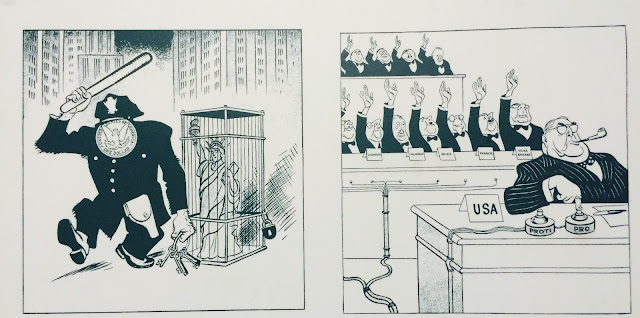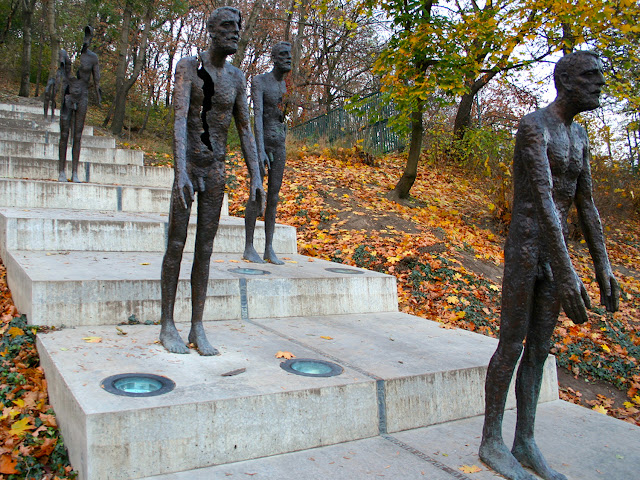Prague
Prague has been my favorite city, by far. Prague wins. What a spectacular city. It is home to about 1.3 million people. It's famous for surviving the violence and destruction of 20th century Europe. As well as being a 1,100 year old city. It has survived being occupied by the Nazis, then after the communist regime. The city has so much history.
The Communism Museum
Below is propaganda that was released by the Soviet Union after they heard of students and citizens becoming enticed by the new ideals of American freedom and progressive movements. In response, the Soviet Union released propaganda showing how 'horrible' American was.
There was also a year in which a lot of crops were destroyed in Czech due to a bug taking over wheat fields. The government released propaganda calling the bug, the "American Bug" claiming that America had released the bug purposefully in order to cause destruction in Czech.
The Astronomical Clock
We went to a Pub called Beer Geek which had 30 taps. There were beers from all over the world. I would highly recommend it! Plus, everyone spoke English, which was awesome because Czech is incredibly difficult. Possibly the only thing keeping me from moving to Prague permanently.
photos by: Carol #ieatlikeamonster
In 1969, the year that Jan Palach lit himself on fire.. the Beatles released Abbey Road.
We walked to the John Lennon Wall and a man was there playing Beatle's songs. We admired all the newly painted support for France. It is a really nice wall, filled with love and peace and freedom and all the right things.
It's crazy to think that the wall was first painted just to irritate the communist regime.. what an incredible way to make a change.
"Mutually Weird"
The French Embassy
The Charles Bridge
The first brick of the famous bridge was laid by Charles IV himself.
Baby Statues
David Cerny is the coolest dude ever. The city asked him to make sculptures of interest, but instead he said.. **** you, I'll do what I want. So he made satirical statues all over the city.
One included super creepy naked baby statues with no faces.
Food
People in Prague eat so much meat!! Every dish has meat in it. A traditional dish is Goulash or Schnitzel. I actually haven't eaten any meat (besides fish & eggs) since coming to Europe, so my stomach didn't handle it well.
I decided on French Toasted Bagels & Fruit for my meal the next morning! Yum.
Prague Castle
Prague Castle: Lobkowicz Palace Concert
Through the 1970s and the 1980s, the government's emphasis on obedience, conformity, and the preservation of the status quo was challenged by individuals and organized groups aspiring to independent thinking and activity. But the state viewed any independent action, no matter how innocuous, as a defiance of the party's control over all aspects of Czechoslovak life. The government's response to such activity was harassment, persecution, and imprisonment. The museum described the ban of music, dance, and anything else that valued creativity or independence of thought or progression. It was literally a story out of 1984.
There was a passage about a man who was describing how a sort of underground market formed with people trading services and goods. People like doctors and mechanics became people of great importance. The government controlled everything, but then they were failing. It was not only tyranny, but also a poorly executed form of communism. The man said, "I went to the grocery store one day and realized that the shelvers were empty." But the scary part about communism is that you cannot go to the authorities, you cannot write an article, you cannot call upon a council.
I walked into a room in the museum & began to watch a video. I felt a pit in my stomach as I read the words, "student protest" and watched police beating protest members with batons, spraying them with hoses and releasing tear gas. The protests were not violent ever. The police wore plain clothing and pretended to be part of the masses until they began beating citizens. They dragged them aside from the crowd then would ask (irrelevant) questions basing their imprisonment off of their school grades, social status, and neighborhood.
I was dumbfounded to find out that it was almost entirely students. We always hear about how the majority of new ideas, revolutions, and political movements begin in colleges, but it really didn't become concrete to me until I was sitting in front of this horrible video.
They watched their parents and teachers become stagnant and demoralized by the communist movement unsure of how to fight back or too afraid.
What really stood out to be was the story of Jan Palach. Jan Palach decided to sacrifice himself in protest of the invasion by setting himself on fire in Wenceslas Square.
Palach did not set himself on fire to protest against the Soviet occupation, but did so to protest against the "demoralization" of Czechoslovak citizens caused by the occupation.
| "It was not so much in opposition to the Soviet occupation, but the demoralization which was setting in, that people were not only giving up, but giving in." If we want to change something, especially in a nation like America, we can. It's a beautiful thing, but it is a matter of Americans, students must become united on a commonality that is good and that is right. |
Below is propaganda that was released by the Soviet Union after they heard of students and citizens becoming enticed by the new ideals of American freedom and progressive movements. In response, the Soviet Union released propaganda showing how 'horrible' American was.
There was also a year in which a lot of crops were destroyed in Czech due to a bug taking over wheat fields. The government released propaganda calling the bug, the "American Bug" claiming that America had released the bug purposefully in order to cause destruction in Czech.
At the end of the museum, there was this. It was a plastic mold of a teenager's hand making a peace sign. I placed my hand in this spot meditating on how many thousands and thousands of teens, students, and people my age had suffered in order to rid their country of communism.
David Cerny is a Czech Sculptor. He has sculptures all over Prague. He became famous in 1991 when he painted a Soviet war tank pink. He was arrest for the act of civil disobedience. But this sculpture most amazes me depicted men who were "victims of communism."
It is the oldest astronomical clock still working today. We climbed to the top right in time to see the sun setting over the tops of the buildings.
We went to a Pub called Beer Geek which had 30 taps. There were beers from all over the world. I would highly recommend it! Plus, everyone spoke English, which was awesome because Czech is incredibly difficult. Possibly the only thing keeping me from moving to Prague permanently.
photos by: Carol #ieatlikeamonster
In 1969, the year that Jan Palach lit himself on fire.. the Beatles released Abbey Road.
We walked to the John Lennon Wall and a man was there playing Beatle's songs. We admired all the newly painted support for France. It is a really nice wall, filled with love and peace and freedom and all the right things.
It's crazy to think that the wall was first painted just to irritate the communist regime.. what an incredible way to make a change.
Then there was a lock bridge..
The French Embassy
The Charles Bridge
The first brick of the famous bridge was laid by Charles IV himself.
David Cerny is the coolest dude ever. The city asked him to make sculptures of interest, but instead he said.. **** you, I'll do what I want. So he made satirical statues all over the city.
One included super creepy naked baby statues with no faces.
Food
People in Prague eat so much meat!! Every dish has meat in it. A traditional dish is Goulash or Schnitzel. I actually haven't eaten any meat (besides fish & eggs) since coming to Europe, so my stomach didn't handle it well.
I decided on French Toasted Bagels & Fruit for my meal the next morning! Yum.
& a delicious Apple Strudel filled Trdelník
Prague Castle: Lobkowicz Palace Concert
Prague is the birthplace of Czech composers Antoni Dvorak, Leos Janacek, and Bedrich Smetana. Also, Mozart premiered Don Giovanni here at the Estates Theater.
I saw all of the concerts behind held around & knew I had to attend one. I have been missing live music so much since being in Europe. I joined music club at school, but I don't get to hear classical music or listen to recitals like at Millikin. I didn't realize how much of an integral part of my life live music is until I heard the first note of a piano and thought I was going to have to leave the room. The tears began instantly and were uncontrollable. There was nothing I could do. It was so magical, sitting in a room that looked like a scene off of Pride & Prejudice in a Castle listening to everything I needed all at once. Music will never stop filling me. I will never go that long again without live music in my life. What a way to learn a lesson. And as I lost myself in the music, I was surrounded by all the things I love most.. St. Charles church, my grandpa's lap, my grandma's laugh, my mother's hands, my favorite painting in Grand Rapids MI, Pride & Prejudice.. all from a song that I had actually never heard live. Art does weird things to a person.
I think it was a mixture of mysticism, love of music, and a little smudge of un-confronted homesickness. I sat alone, weeping to the Turkish Waltz...which is absurdly ridiculous. The lady in front of me turned and handed me a tissue staring at me as if I was completely insane. I wept through the entire concert, but never felt so happy and rejuvenated afterward.



































